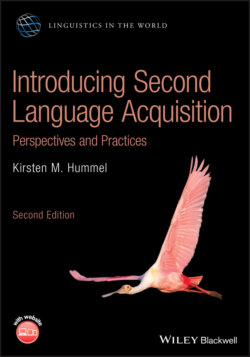Читать книгу Introducing Second Language Acquisition - Kirsten M. Hummel - Страница 27
2.4.4 emergentism: connectionist viewpoint
ОглавлениеA relatively recent theoretical view concerning language acquisition stems from what has been termed emergentism. In this perspective, “language development is no longer seen as a process of acquiring abstract rules, but as the emergence of language abilities in real time …” (Evans 2009, p. 128). A language‐specific learning device is not considered to be innately specified, as proposed by the UG approach. Instead, inspired by the structure of the nervous system, proponents of this view suggest that language emerges out of a complex network of interconnections between neurons (e.g. Elman et al. 1996).
emergentism
Theoretical view proposing that phenomena of language are best explained by reference to more basic nonlinguistic factors and their interaction (e.g. physiology, perception, processing, input properties, etc.).
One predominant emergentist‐inspired model is connectionism, which proposes that language is learned through exposure to language in the environment, the input. This exposure allows the construction of associations among units, i.e. sound sequences, words, sentence patterns, etc. The L1 develops, therefore, through ongoing exposure to language in the environment with increasing exposure to certain units leading to greater associative strengths. When the associations are strong enough, the units and patterns become permanently acquired. One often‐cited test of this model (Rumelhart and McClelland 1986) used computer simulation to examine past tense acquisition on verbs and found that the model predicted learning sequences found in typical L1 English past tense acquisition: i.e. U‐shaped learning (referred to in Section 2.3) in which the correct irregular past tense form “went” appeared first, followed by the incorrect over‐regularization “goed” or “wented,” finally returning to the correct form “went.” The connectionist viewpoint therefore suggests overregularization behavior can be explained by the child's sensitivity to the frequency of the forms in the input, in contrast to the UG approach which uses such examples as evidence of an underlying rule system.
connectionism
Theoretical view proposing that language is learned through exposure to input allowing the construction of associations among units, i.e. sound sequences, words, sentence patterns, etc.
There are both supporters and critics of this relatively recent approach. While there is evidence that the model may account for specific aspects of L1 learning such as irregular past tense forms, as indicated in the preceding paragraph, the connectionist model is still in the early stages of testing. One specific critique is that it is not clear how connectionism can account for the effect of nonlinguistic, contextual information, such as tone of voice, gestures, etc., in language acquisition (Tomasello, cited in Paradis 2004). Chapter 5 will discuss emergentist approaches with regard to their relevance to L2 acquisition.
There are of course other theoretical views on language acquisition, but the ones discussed briefly in this section can be considered as particularly relevant for the examination of second language acquisition that we will undertake in the following chapters.
